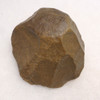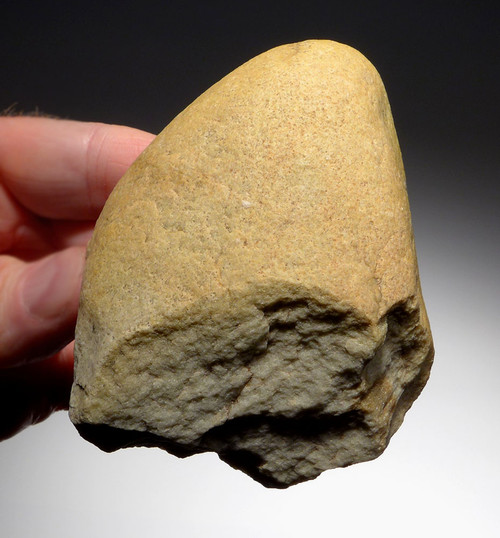Product Description
This is a classic OLDOWAN PEBBLE CHOPPER AXE. It was made in a reduced size for secondary butchering task such as separating meat, and cutting hide and tendons. Fashioned out of basalt, It has been colored a honey dark gold hue from the Saharan minerals and wind exposure, pebbling the surface and depositing an incredible natural gloss. It displays a perfect textbook form for this type of prehistoric tool. The micro-crevices are filled with desert sediment and all surfaces including the cutting edges, show desert wind-polishing and patina, testifying to its authenticity. Portions of the axe that would have received more exposure, display a SPECTACULAR wind erosion feature giving the surface a 'melting ice cream", lustrous appearance, called "desert varnish", from millennia of exposure to the Saharan wind and long-term silica deposition on the surfaces. It is just an incredible tool to hold and not only fits in the hand perfectly, it has a masterfully made chisel end made by several opposing strikes.
This genuine stone tool artifact is a perfect candidate for demonstrating the earliest primary human stone tool of the Oldowan Tradition of Africa's Lower Paleolithic Period. The chopping edge is complete showing multiple strikes when originally made. The grip is well-conceived with a natural flat surface of the original cobble stone on the proximal end being oriented as a grip to fit against the palm when held, cushioning heavy blows when in use.
HISTORY
Oldowan pebble tools are THE FIRST recognized tools invented by the earliest of primitive humans from Africa. The Oldowan (or Mode I) was a widespread stone tool archaeological industry (style) in prehistory. These early tools were simple, usually made with one or a few flakes chipped off with another stone. Oldowan tools were used during the Lower Paleolithic period, 2.6 million years ago up until at least 1.7 million years ago, by ancient Hominins (early humans) across much of Africa. This technological industry was followed by the more sophisticated Acheulean industry. Oldowan stone tools are simply the oldest recognizable tools which have been preserved in the archaeological record. Early species of Homo such as H. habilis and H. ergaster are believed to be the primary tool makers of the industry during much of its use. Early Homo erectus appears to inherit Oldowan technology and refines it into the Acheulean industry beginning 1.7 million years ago.
The term Oldowan is taken from the site of Olduvai Gorge in Tanzania, where the first Oldowan stone tools were discovered by the archaeologist Louis Leakey in the 1930s. Some contemporary archaeologists and palaeoanthropologists prefer to use the term Mode 1 tools to designate pebble tool industries (including Oldowan), with Mode 2 designating bifacially worked tools (including Acheulean handaxes), Mode 3 designating prepared-core tools, and so forth.
There is a flourishing of Oldowan tools in eastern Africa, spreading to southern Africa, between 2.4 and 1.7 mya. At 1.7 mya., the first Acheulean tools appear even as Oldowan assemblages continue to be produced. Both technologies are occasionally found in the same areas, dating to the same time periods. This realization required a rethinking of old cultural sequences in which the more "advanced" Acheulean was supposed to have succeeded the Oldowan. The different traditions may have been used by different species of hominins living in the same area, or multiple techniques may have been used by an individual species in response to different circumstances.
By 1.8 mya early Homo was present in Europe, as shown by the discovery of fossil remains and Oldowan tools in Dmanisi, Georgia. Remains of their activities have also been excavated in Spain at sites in the Guadix-Baza basin and near Atapuerca. Most early European sites yield "Mode 1" or Oldowan assemblages. The earliest Acheulean sites in Europe only appear around 0.5 mya. In addition, the Acheulean tradition does not seem to spread to Eastern Asia. It is unclear from the archaeological record when the production of Oldowan technologies ended. Other tool-making traditions seem to have supplanted Oldowan technologies by 0.25 mya.
No one can doubt the importance that pebble tools hold in the history of human development. Their very emergence in Africa allowed the earliest humans to butcher animals for their meat - the needed nourishment that allowed humans to survive and flourish to one day populate and rule the earth.
 US DOLLAR
US DOLLAR
 EURO
EURO
 AUSTRALIAN DOLLAR
AUSTRALIAN DOLLAR
 CANADIAN DOLLAR
CANADIAN DOLLAR
 POUND STERLING
POUND STERLING


























